#An Illustrated Guide to Korean
Explore tagged Tumblr posts
Text
S-Classes that I Raised/My S-Class Hunters information post


내가 키운 S급들 | S-Classes that I Raised (“SCTIR”) is an ongoing Korean fantasy webnovel on Munpia, Naver, Ridibooks, and Kakao by 근서 | Geunseo that has been adapted into an ongoing manhwa/webcomic (My S-Class Hunters) (though the manhwa is on hiatus at the moment after the conclusion of season 1). The second cover art is by onlyraii. The novel is published by 제이플미디어 | JAYPLEMEDIA.
Manhwa adaptation summary: "Yoojin is an F-ranker overshadowed by his little brother, an S-ranker. All he does is get in his brother’s way, causing trouble wherever he goes. When a seemingly routine dungeon raid goes wrong and costs Yoojin his brother’s life, Yoojin decides to use the wish granted by clearing the dungeon to reset his timeline. The plan was to lead a quiet life from now on… but now it turns out he can help other people become S-rankers?! Maybe this is Yoojin’s chance at building his own entourage of powerful metahumans… but it may be easier said than done." - Naver Webtoon
SCTIR the webnovel has an 858-episode main story, a 14-episode epilogue, a completed 167-episode Side Story (sequel) and an ongoing 27-episode Afterward/Later Story (sequel). It was first published on June 29th, 2018 (Munpia).

The main story and epilogue were reformatted into 35 ebooks (Naver, Ridibooks, Kakao), which began publication on May 1st, 2020, and the ebooks have interior illustrations from 비완 | Biwan for volumes 1-14 and a few other artists for the other 21 volumes. Here's a post on some of the interior art that JPLE has shared online.
The ebooks also have extra scenes in various places and possible revisions, which differs from what is available in the individual episodes. The Korean ebooks also began being released in paperback in November 2024.
A guide for reading SCTIR on Munpia and Naver (this is meant for another fandom, but it's also designed to work for anyone who wants to read any similar works on Munpia and Naver).
This is meant to be a collective post for information on the novel and manhwa, as well as translations, which will update as new information comes up.
Geunseo
Geunseo is the author of the webnovel. Back in mid-2022, Geunseo replied to questions from readers in a very long Q&A, which folks shared on various platforms.
Translations of the webnovel
There is no official English translation of the webnovel, though there are a few fan translators, but most are just people putting the episodes through machine translators ("MTL") and sharing those online, or doing modified/partial MTL, which involves MTL most/all of the episode and doing partial translation/editing on the results. There is also a lot of confusion because people tend to MTL the individual episodes, not the revised ebooks, so folks reading one but not the other one are going to have different understandings of the story.
Side Stories/Sequels
There are two side stories for SCTIR, both of which are sequels to the part that came before. The order is main story (not an official name, it's just the regular story) > Epilogue > Side Story > Afterward/Later Story. Side Story and Afterward/Later Story are only available on Naver for some reason.
SCTIR manhwa, My S-Class Hunters


SCTIR's manhwa adaptation is published on Naver Comics / Naver Series, began publication on November 15th, 2021, and is 153 episodes long. There's a trailer from right before it released on YouTube.
youtube
The manhwa is adapted by 제이플미디어 | JAYPLEMEDIA, with principle art by 비완 | Biwan, and the head of storyboard is seri. Other crew on the team include 징개 JINGGAE | JING_GAE (assistant direction), 김피로(KPR) | tired_kim, and 한흔 | hanheunhan. A lot of the crew share previews and behind the scenes material on their twitters. Although the manhwa is very far behind the novel, the crew are generally novel fans (Biwan did art for the ebooks, after all), and they will also sometimes do fanart for recent episodes of Side Story/Afterward, so be wary if you want to avoid spoilers. The manhwa currently stops in volume 7 of the novel, around episode 168.
The manhwa also differs in many ways from the novel, which is normal for an adaptation. Changes include some chronological reorganization of events, expansion of certain characters and relationships, some modifications to skills, additional scenes, etc.
The original Korean updates weekly on Naver on Tuesdays around 10:30-11:00 AM ET, though it's currently on hiatus after the conclusion of season 1. Most translations are currently some ways behind the original Korean, so they have a bit to catch up on during the hiatus if they're ongoing.
The English translation updates weekly at 9 PM ET on Wednesdays on Webtoon, and at 00:00 ET on Wednesdays on Tappytoon. The Webtoon version is free to read, but the last several episodes are paywalled, and these episodes can be accessed by cookies (the currency on Webtoon). Guide for how to read for free on Tappytoon. SCTIR's manhwa is also available online in French (though it seems to be on a hiatus since 2022), German, Japanese (俺が育てたS級たち), Spanish (Los clase S que crié), and Thai.
April Fool's Day Jokes
Both the novel and manhwa teams, like a lot of Webtoon manhwa teams, usually do a joke post for April Fool's Day.
The 2022 joke post for the novel was seemingly a parody of the then-unreleased novel cover by onlyraii. The 2022 joke post for the manhwa was a magical girl Yoohyun parody.

The 2023 joke post for the manhwa was Yoojin, Yerim, Yoohyun, and Peace making heart signs.

The 2024 joke post for the manhwa was to have most of the cast become dinosaurs.

#my s class hunters#sctir#s classes that i raised#informational post#fallfposts#내가 키운 S급들#mysclasshunters#sclassesthatiraised
86 notes
·
View notes
Text
Film Grammar for Simmers
What is film grammar?
"Film grammar" refers the unstated "rules" of editing used in movies and TV. Different types of shots have different associations and are used by editors to convey different types of information to the audience. Many of these principles were first described in the early 20th century by Soviet directors, but they're used consistently across genre, medium, and even language: Bollywood musicals, English period dramas, Korean horror movies, and American action blockbusters all use many of the same techniques.
Because these rules are so universal, virtually everyone has some internalized understanding of them. Even if they can’t name the different types of shots or explain how editors use images to construct meaning, the average person can tell when the “rules” are being broken. If you’ve ever thought a movie or episode of TV was confusing without being able to say why, there’s a good chance that there was something off with the editing.
Learning and applying the basics of film grammar can give your story a slicker and more-polished feel, without having to download shaders or spend hours in photoshop. It also has the bonus of enhancing readability by allowing your audience to use their knowledge of film and TV to understand what's happening in your story. You can use it to call attention to significant plot details and avoid introducing confusion through unclear visual language.
Best of all, it doesn't cost a dime.
The basics: types of shots
Shots are the basic building block of film. In Sims storytelling, a single shot is analogous to a single screenshot. In film, different types of shots are distinguished by the position of the camera relative to the subject. There are three big categories of shots, with some variation: long shots (LS), medium shots (MS), and close-ups (CU). This diagram, created by Daniel Chandler and hosted on visual-memory.co.uk illustrates the difference:
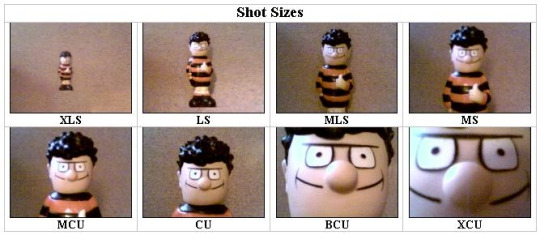
Source: The 'Grammar' of Television and Film, Daniel Chandler, visual-memory.co.uk. Link.
In film, scenes typically progress through the different types of shots in sequence: long shot, medium shot, close-up. When a new scene begins and the characters arrive in a new location, we typically begin with a wide establishing shot of the building’s exterior to show the audience where the scene will be taking place. Next comes a long shot of an interior space, which tells the where the characters are positioned relative to one another. The next shot is a medium shot of the characters conversing, and then finally, a close-up as the conversation reaches its emotional or informational climax. Insert shots are used judiciously throughout to establish themes or offer visual exposition.
Here's another visual guide to the different types of shots, illustrated with stills from Disney animated films.
This guide is almost 2,000 words long! To save your dash, I've put the meat of it under the cut.
Long shot and extreme long shots
A long shot (sometimes also called a wide shot) is one where the entire subject (usually a building, person, or group of people) is visible within the frame. The camera is positioned far away from the subject, prioritizing the details of the background over the details of the subject.
One of the most common uses of long shots and extreme long shots are establishing shots. An establishing shot is the first shot in a scene, and it sets the tone for the scene and is intended to give the viewer the information they’ll need to follow the scene: where a scene is taking place, who is in the scene, and where they are positioned in relation to one another. Without an establishing shot, a scene can feel ungrounded or “floaty.” Readers will have a harder time understanding what’s happening in the scene because on some level, they’ll be trying to puzzle out the answers to the who and where questions, distracting them from the most important questions: what is happening and why?
(I actually like to start my scenes with two establishing shots: an environmental shot focusing on the scenery, and then a second shot that establishes the characters and their position within the space.)
Long shots and extreme long shots have other uses, as well. Because the subject is small relative to their surroundings, they have an impersonal effect which can be used for comedy or tragedy.
In Fargo (1996) uses an extreme long shot to visually illustrate the main character’s sense of defeat after failing to secure funding for a business deal.The shot begins with a car in an empty parking lot, and then we see the protagonist make his way up from the bottom of the frame. He is alone in the shot, he is small, and the camera is positioned above him, looking down from a god-like perspective. All of these factors work together to convey his emotional state: he’s small, he’s alone, and in this moment, we are literally looking down on him. This shot effectively conveys how powerless he feels without any dialogue or even showing his face.

The same impersonal effect can also be used for comic purposes. If a character says something stupid or fails to impress other characters, cutting directly from a close-up to a long shot has a visual effect akin to chirping crickets. In this instance, a long shot serves as a visual “wait, what?” and invites the audience to laugh at the character rather than with them.
Medium Shots
Medium shots are “neutral” in filmmaking. Long shots and close-ups convey special meaning in their choice to focus on either the subject or the background, but a medium shot is balanced, giving equal focus to the character and their surroundings. In a medium shot, the character takes up 50% of the frame. They’re typically depicted from the waist-up and the audience can see both their face and hands, allowing the audience to see the character's facial expression and read their body-language, both important for interpreting meaning.
In most movies and TV shows, medium shots are the bread and butter of dialogue-heavy scenes, with close-ups, long shots, and inserts used for punctuation and emphasis. If you’re closely following the conventions of filmmaking, most of your dialogue scenes will be medium shots following the convention of shot-reverse shot:
youtube
To keep long conversations from feeling too visually monotonous, consider staging the scene as a walk-and-talk. Having two characters move through a space can add a lot of dynamism and visual interest to a scene that might otherwise feel boring or stiff.
Close Ups
Close-ups are close shots of a character’s face. The camera is positioned relatively near to the subject, showing just their head and shoulders. In a close-up, we don’t see any details of the background or the expressions of other characters.
In film, close-ups are used for emphasis. If a character is experiencing a strong emotion or delivering an important line of dialogue, a close-up underscores the importance of the moment by inviting the audience to focus only on the character and their emotion.
Close-ups don’t necessarily need to focus on the speaker. If the important thing about a line of dialogue is another character’s reaction to it, a close-up of the reaction is more effective than a close-up of the delivery.
One of the most iconic shots in Parasite (2019) is of the protagonist driving his employer around while she sits in the backseat, speaking on the phone. Even though she’s the one speaking, the details of her conversation matter less than the protagonist’s reaction to it. While she chatters obliviously in the background, we focus on the protagonist’s disgruntled, resentful response to her thoughtless words and behavior.

In my opinion, Simblr really overuses close-ups in dialogue. A lot of conversation scenes are framed entirely in close-ups, which has the same effect of highlighting an entire page in a textbook. The reader can’t actually tell what information is important, because the visuals are screaming that everything is important. Overusing close-ups also cuts the viewer off from the character’s body language and prevents them from learning anything about the character via their surroundings.
For example, a scene set in someone’s bedroom is a great opportunity for some subtle characterization—is it tidy or messy? what kind of decor have they chosen? do they have a gaming computer, a guitar, an overflowing bookshelf?—but if the author chooses to use only close-ups, we lose out on a chance to get to know the character via indirect means.
Inserts
An insert shot is when a shot of something other than a character’s face is inserted into a scene. Often, inserts are close-ups of a character’s hands or an object in the background. Insert shots can also be used to show us what a character is looking at or focusing on.
In rom-com The Prince & Me (2004) (see? I don’t just watch crime dramas…) the male lead is in an important meeting. We see him pick up a pen, look down at the papers in front of him, and apparently begin taking notes, but then we cut to an insert shot of his information packet. He’s doodling pictures of sports cars and is entirely disengaged from the conversation. Every other shot in the scene is an establishing shot or a medium shot or a close-up of someone speaking, but this insert gives us insight into the lead’s state of mind: he doesn’t want to be there and he isn’t paying attention.

Insert shots are, in my opinion, also used ineffectively on Simblr. A good insert gives us extra insight into what a character is thinking or focusing on, but a poorly-used insert feels…unfocused. A good insert might focus on pill bottles on a character’s desk to suggest a chemical dependency, on a family picture to suggest duty and loyalty, on a clock to suggest a time constraint, on a pile of dirty laundry or unanswered letters to suggest a character is struggling to keep up with their responsibilities. An ineffective insert shot might focus on the flowers in the background because they’re pretty, on a character’s hands because it seems artsy, on the place settings on a dining table because you spent forever placing each one individually and you’ll be damned if they don’t make it into the scene. These things might be lovely and they might break up a monotonous conversation and they might represent a lot of time and effort, but if they don’t contribute any meaning to a scene, consider cutting or repurposing them.
I want to emphasize: insert shots aren’t bad, but they should be carefully chosen to ensure they’re enhancing the meaning of the scene. Haphazard insert shots are distracting and can interfere with your reader’s ability to understand what is happening and why.
Putting it all together
One of the most basic principles of film theory is the Kuleshov effect, the idea that meaning in film comes from the interaction of two shots in sequence, and not from any single shot by itself. In the prototypical example, cutting from a close-up of a person’s neutral expression to a bowl of soup, children playing, or soldiers in a field suggests hunger, worry, or fear, respectively.
youtube
The Kuleshov effect is the essence of visual storytelling in a medium like Simblr. You can elevate your storytelling by thinking not only about each individual shot, but about the way they’ll interact and flow into one another.
Mastering the basics of film grammar is a great (free!) way to take your storytelling to the next level. To learn more, you can find tons of guides and explainers about film grammar for free online, and your local library doubtless has books that explain the same principles and offers additional analysis.
Happy simming!
#armorica tips#armorica ooc#i finally got off my ass to finish this guide which i started back in August right before I got extremely sick and ended up in the hospital#anyway....hope you enjoyed this post which was a veiled excuse for me to complain about how people overuse close-ups and inserts#and i can't tell what's happening in their stories ;fdsklsjadf;laksdf#Youtube
345 notes
·
View notes
Note
What is time princess about? I've been seeing it on the Play store but I have no idea if to download it
hello anon! I'd be glad to give you an overview and some tips for starting out! :D

Time Princess is what happens when all your childhood dreams of getting transported into a book come true.
At heart, the game is a set of continual isekai stories, transporting you to different "books" with the help of a magic desk and giving you "create your own adventure" options to see how the story plays out.
Your fairy companion Isabelle helps you learn the ropes, and you have to go through one mandatory book (a Marie Antoinette themed story) to get access to your room and the larger bookstore
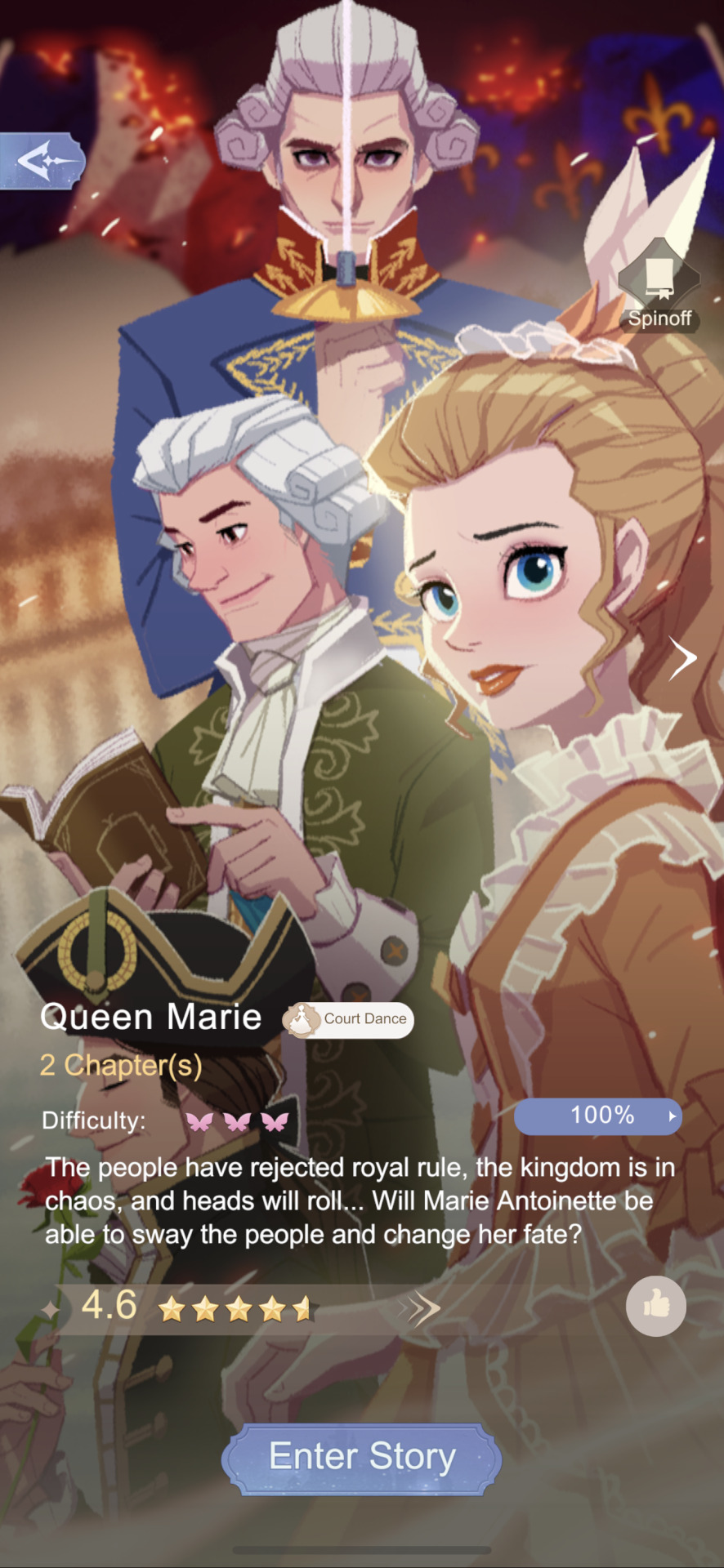

(I'll put the rest under a read more bc it'll get long)
For each chapter you complete, you earn 1-3 tickets. With these tickets, you can unlock new books! The more you play, the more you earn towards new stories.
The game currency works on a coins and diamonds system--you don't NEED to purchase anything to play (though it may make the game a bit easier in some areas)
You get free stamina to access books and crafting materials every 11 hours and the Time Princess discord server has codes pretty frequently for diamonds, tickets, etc.


I personally splurge for the Fashion Booster every 2 months because I know it helps support the game and the artists! I try not to use real money on the random outfits unless I REALLY want one bc it can get addictive.
One of my favorite parts of the game is that, as you play, you unlock "album" art (full color illustrations that tie into the story!!)
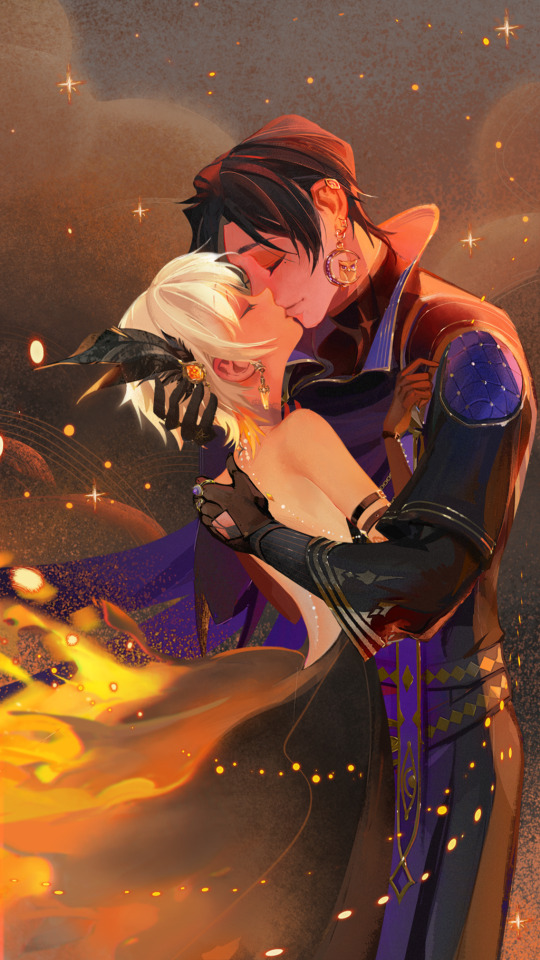



One other thing I love is that the game is very targeted towards Bisexuals, as there are TONS of queer wlw story lines (though because of the games' popularity overseas and censorship, often gets called "best friends" etc)
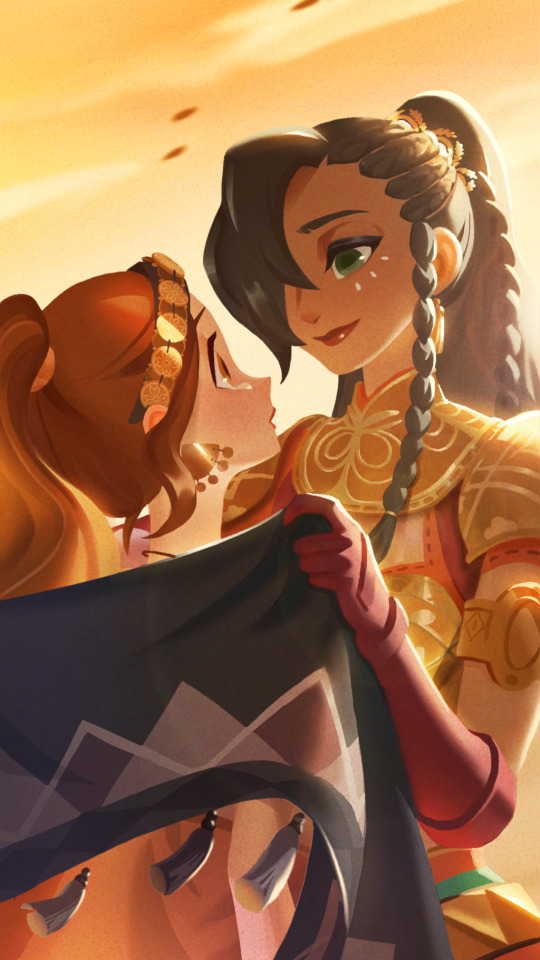

Another fun part is the variety of stories!!!! There's art history!! There's stuff based on old fairy tales like Swan Lake. There's fantasy stories like The Apothecary. There's a Pirate story!!! There's Chinese, Japanese, and Korean stories. There's a western cowboy story! There's futuristic scifi!!! There's a victorian flavored horror story!!!
Most, if not all, of the stories are with adult characters and have adult storylines!! (the books will also give you a content warning before downloading)
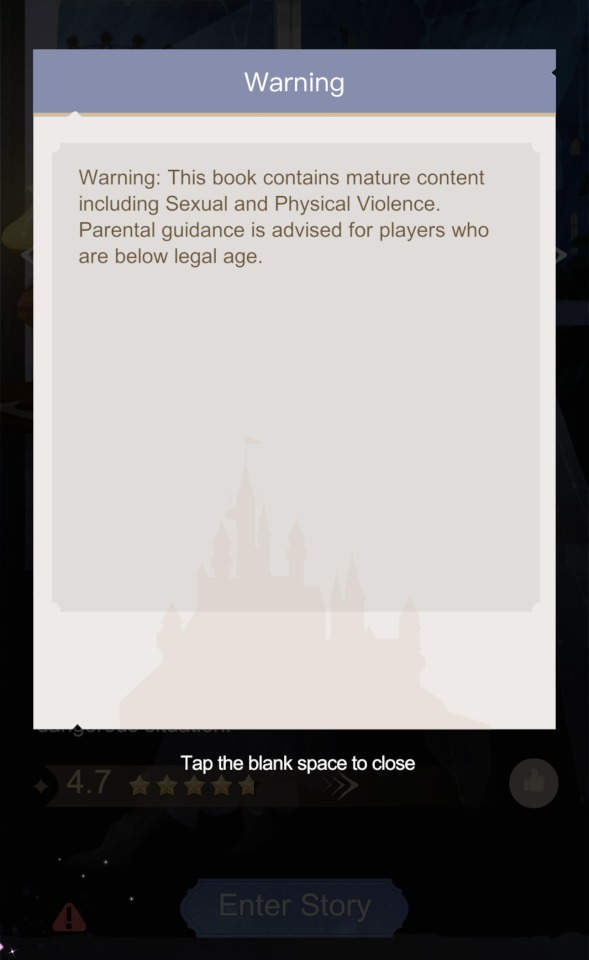
On top of the stories, there's plenty of other fun aspects--mini games, fashion challenges, checking in with your companions every day to earn crafting materials, joining a society, playing events, and just playing dress up with your outfits and taking pics for fun.
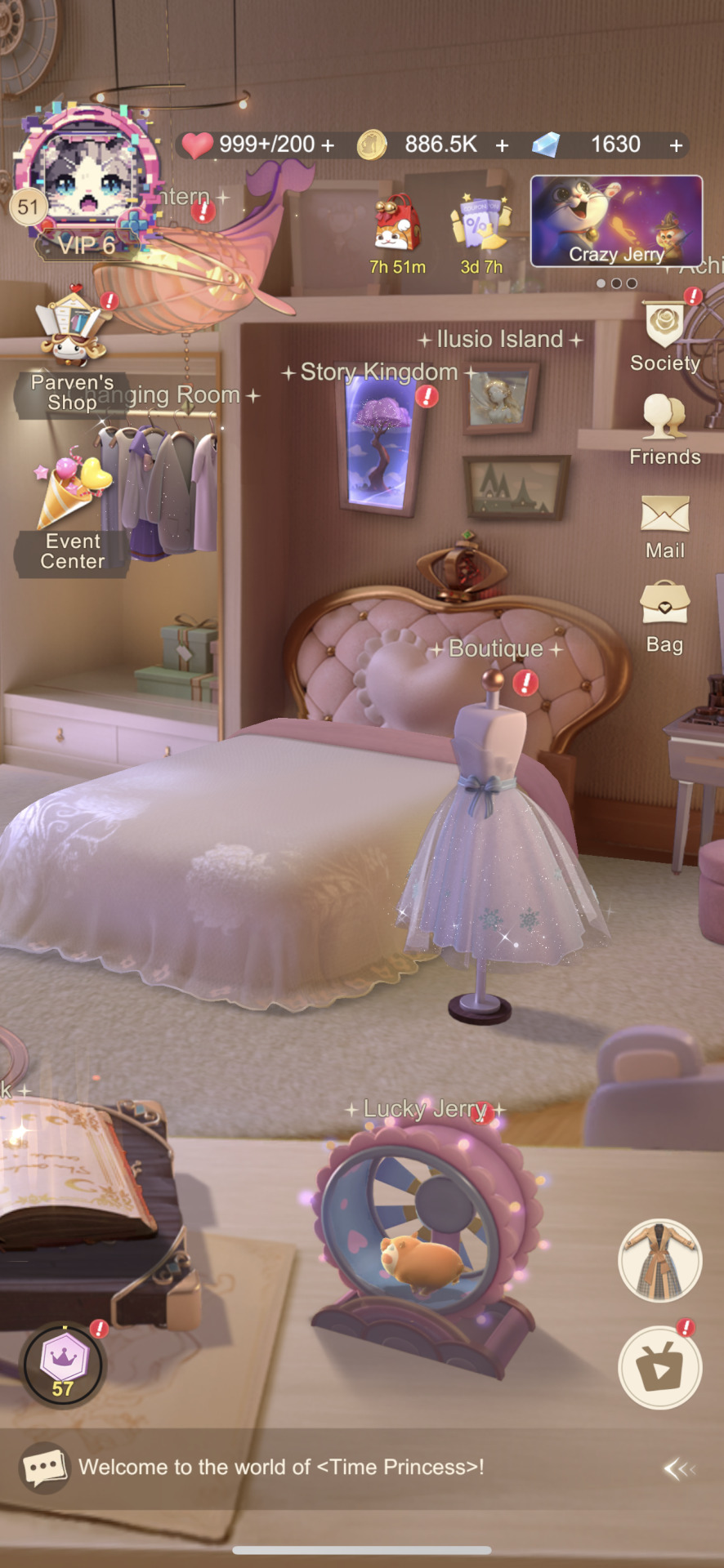
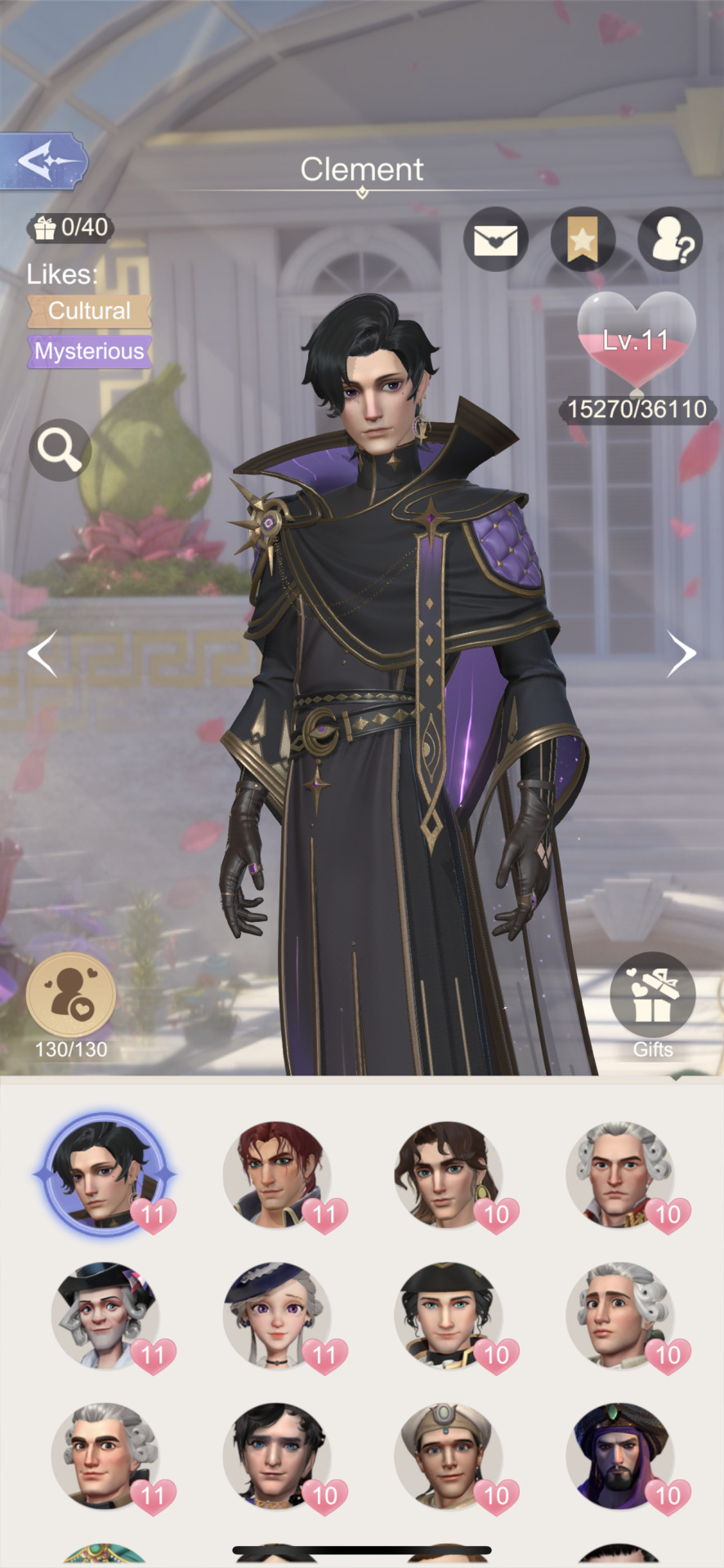
The discord community is great too, and there's often interview nights with some of the book authors and giveaways of materials and prizes (I actually ended up winning a plushie Lafayette one time!)
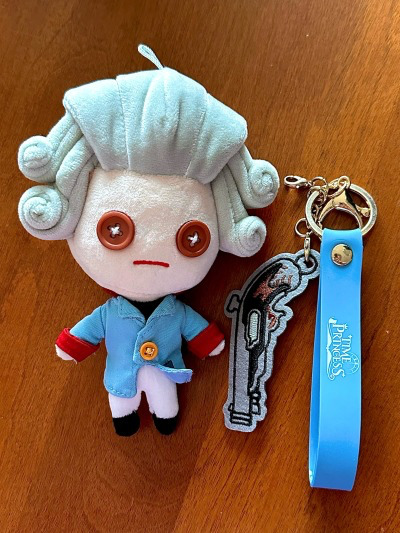
The discord server also has game guides and walkthroughs for everything!



Everyone who plays the game gets really into the stories and characters, so even though the tumblr presence of fans may be smaller, you have an immediate bond with the other players!!!
They've also done some really cool collabs with museums like The Louvre and the Flamenco museum. You get to earn clothes from famous paintings or historical ones during that event period!

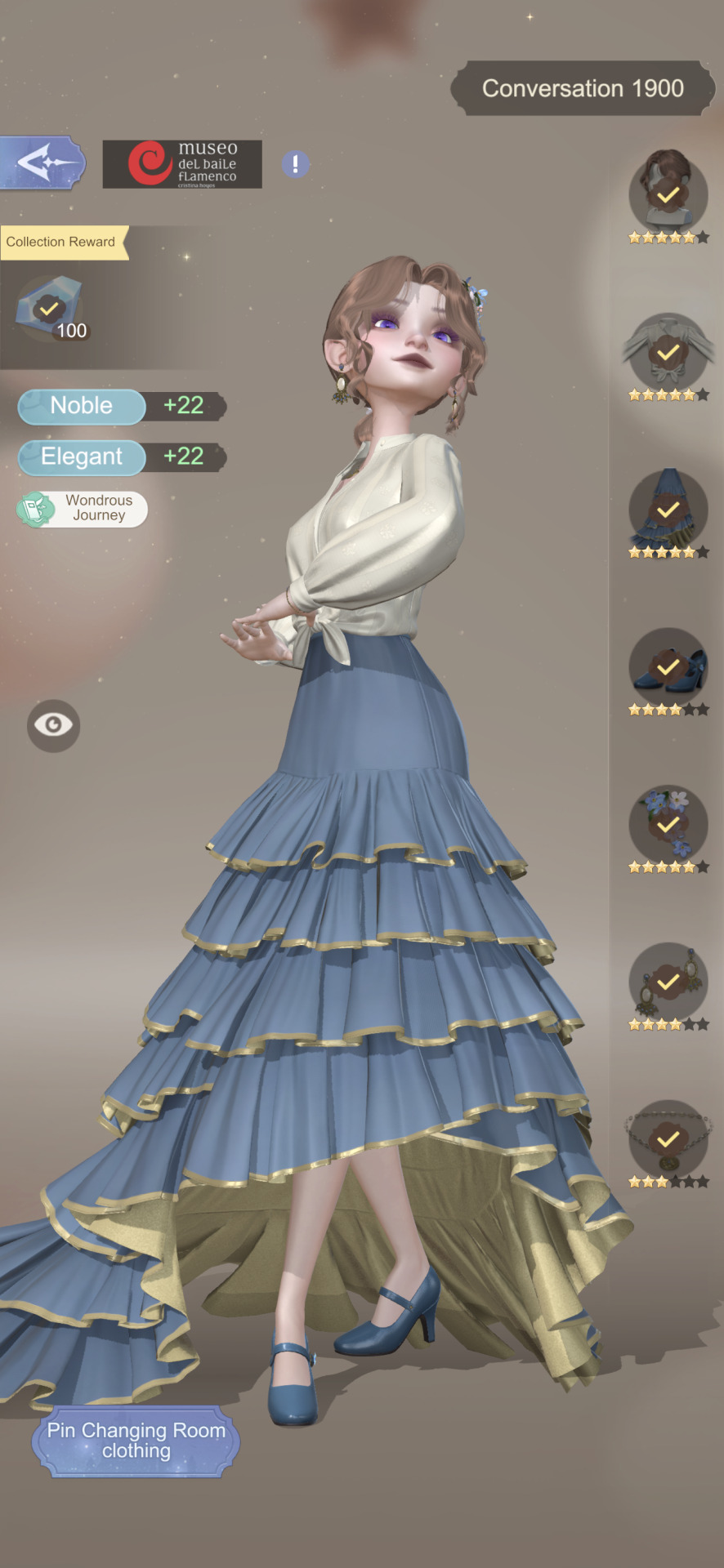
Finally, don't forget to save your big clothing crafting for Saturdays! You get double the materials!!

#time princess#dutp#for the fellow fans! if i need to add anything else lmk!#long post#i love you time princess
40 notes
·
View notes
Note
hi yeri !! just wanted to ask where you get your resources for korean mythology from?
hihiiii! i do the majority of my research by purchasing or borrowing books, cross-referencing classical documents, reading academic papers, and government websites! i'll also do museum visits and in the future i'm planning on conducting interviews (i've done one with a mudang before, and she was reaaaally helpful!) i'm not a history major so i struggle with compiling resources, and for that reason i try to limit my inquiry to the methods i listed above!
***wikipedia should not be utilized as a primary source! i've verified incorrect information in there before, at most it should be used as a collection for sources cited***
i'll try and recommend a handful of the more beginner sources i like, but please note that i have no idea whether or not most of these have english translations!
an illustrated guide to korean mythology (by won-oh choi, this one is in english!)
veritable records of the joseon dynasty (실록)
memorabilia of the three kingdoms (삼국유사)
history of the three kingdoms (삼국사기)
classic of the mountains and seas (山海经)
goguryeo arirang by park jijeong
the unknown history of baekje by jeong jaesoo
living korean myths by shin dongheun
jeju island's bonpuri and the myths around it by heo namchun
the gods are divided by seongtae yoon
encyclopedia of korean culture (website)
terms you may find helpful to search up
한국 신화 (hanguk shinhwa, or korean mythology)
건국 신화 (gonguk shinhwa, or state-foundation myths)
#chrys oberyl#it's difficult work to find a lot at first#confucianism rooted out indigenous belief#and a lot of original records are believed to be lost to history#japanese colonization also destroyed massive portions of recorded history#palaces were destroyed#temples were burned#artifacts were looted#etc
30 notes
·
View notes
Text
Professional translations & public witch hunts
For starters: If you think "TL;DR, who cares, I ain't reading all that" and are incapable of processing words for a prolonged amount of time beyond 240 character clickbait, you are not entitled to an opinion on translation to begin with.
I will take sufficient time for this one.
General:
In recent weeks I've repeatedly had the misfortune of coming across public harassment and incited hate mobs towards Jujutsu Kaisen's manga translator.
There's hordes of anti-social harassers pushing for someone to get fired from a professional job - in which he works because he is equipped with the necessary qualifications - purely due to disliking occasional translation choices in a comic.
This behavior has reached levels of exaggeration and reality disconnect, it'd be funny if it wasn't so sad due to a real person's livelihood being attacked.
This is not normal and tolerable behavior. It is equal to drumming up a hate mob in front of a café and threatening some employee inside, throwing rocks at the window and demanding for a barista to get fired because you didn't like the coffee beans they chose, or sure, maybe because they put actual sugar instead of sweetener into your coffee.
This is not a normal and acceptable way to behave.
If you think it is, there is something deeply wrong with your perception of society and what's respectful conduct towards another human being. When you encounter another person, you act respectfully at the very least. Kind, ideally.
Feel free to imagine yourself at work, making a mistake and thousands of people starting to call, email, shitpost online and harass you over it, dragging you publicly, shouting on the parking lot for you to be fired. Please reflect on yourself.
Now:
This dude does comic translations.
He did not authorize biochemical weapons in a war. He did not pass a law to deport all migrants and close the borders. He did not accidentally kill someone during a surgery. He did not hack & rob the annual employee bonus' account.
He wrote a word you don't like in a comic.
Planet Earth to Werry hater: Please come back down to reality and dial it back a few notches. This is a non-issue. Whether he makes mistakes or not, this level of hate and harassment is ENTIRELY out of pocket.
Moving on to translations.
Translations/criticizing translations:
Opinions on translations are like assholes - everyone got one. But that doesn't mean you need to pull them out in public. And especially not that you have to shit into random people's lives with them.
I've been reading manga and playing games in private for 27 years. I speak 4 Western languages and A2.2 Japanese. I've been working in the international entertainment industry with a focus on Asian to Western markets for over a decade, including Chinese, Japanese & Korean.
A lot of my time at work is filled with liaising between East and West, internally as well as externally. In my career, I've spent a lot of years supporting and later on consulting on localization.
I know what it is like to be a fan, and I am fully aware of the work reality behind translation.
I'm also intricately aware of the difficulties one faces when interpreting (!) from a source language as abstract and contextual as Japanese to a spelled out language such as English, French, Spanish, German, etc.
You cannot do a 1:1 translation. The nature of these languages is so different, you have to decide on one of many ways to translate something. And oftentimes, the content is so vague with so few indicators, the only thing you can do is guess and hope for the best - unless you happen to hit a rare jackpot of a person who has a guide with additional info and is able to provide this within the short deadline you are left with.
Even the most basic words already illustrate this difference.
Look at the example of
元気ですか / げんきですか = Genki desu ka
Genki is an adjective, "desu ka" is a question particle similar to "is it".
Genki already has many similar variants in meaning: "lively; full of spirit; energetic; vigorous; vital; spirited"
It is commonly translated as "How are you?" but that is not what it literally means.
Since "Genki desu ka?" is commonly used after the initial greeting when meeting someone, "How are you" is the closest equivalent to it in EN, due to it's function and usual placement within a dialogue.
The literal translation would be "Energetic is it?", or "Lively is it?"
That is obviously is no proper English.
Adjusting for grammar, it could be changed to "Are you lively?" - but the "you" is already a "fictional addition" to the sentence, as the original JP has no adress like this.
And asking someone if they are "lively" is also out of place. So more changes are needed.
Further adjusted for "natural sounding" would be "Are you doing good?" which now has 2 additional made up words, to transfer the question from JP to EN - "you" and "good".
This sentence does not necessarily have to mean "Are you good/How are you?". If I tell you my aunt Emma sends her regards, and you reply "Ah. Genki desu ka?" the translation would be "Oh. How is (Emma) doing?/Is Emma doing good?" JP's grammar works without these precise indicators who is talking about whom and is highly contextual whereas - Western languages need those.
Concluding, depending on who is talking to one another, who was mentioned on a page before, etc. a simple "Genki desu ka?" can be anything from "How are you?" to "Is (Panda) doing good?".
There is no literal 1:1 translation possible. The languages are too different.
The reality of translation is unclear source material open to multiple interpretations, once you settle on an interpretation having another dozen options to decide on for the specific wording, then having to adjust that to character and spacing limitations and doing all that with little turnover time.
On top of that, official translations work with styleguides and glossaries.
There could e.g. be a kind of character bible with notes about all characters and their peculiar ways of talking and what character traits those convey and an instruction to use approach XYZ to convey that.
"Speaks in a very poetic way, very roundabout and meandering" which could e.g. lead to overhauling the literal translation to add "personality" based on that.
Going by "(O) genki desu ka?" suddenly "How are you?"for the "poetic trait" becomes "How has life been treating you?"
Again - at the end overhauled again to make room for character limits and such, so maybe it becomes "How fare you?"
This change could have been added not because this particular line offers the exact context, but it is rooted in a style instruction to work with a certain speech pattern/type for a character - since the JP indicators at another spot might not offer satisfactory EN translations, so you have to add the "personality" elsewhere.
Translations of ongoing works utilize glossaries and you cannot use new terms if there is already a term established and submitted. Else it would be a mess of e.g. Cursed Energy in Chapter 2, Jinxed Force in Chapter 25, Hex Flow in Chapter 112, Curse Power in Chapter 156, Hex Energy in Chapter 287, etc.
Even if some months or years in you think another translation would be better suited, you are obliged to keep consistency with previous mentions and cannot just change these.
This also means if you take over translation work started by someone else, you have to work with their groundwork and established rules and terms and cannot change them.
Official translations commonly aim to make a foreign work accessible to local readers. If there is a bunch of teenage characters going to school, they should be relatable to local teenagers. As a result, regional and current slang might be added to make it sound more natural whereas the JP might just have "informal" indicators but less variance in vocabulary. The goal of a translation is to make a work accessible to a whole new language audience, hence the focus lies on making it readable without a prior 8 year degree in cultural studies. Things get simplified or changed for that reason.
Usually translators for a work consult with each other what the difficulties translating are, what possible options are, and what each language will run with. These considerations take a lot of time.
Having fans work out occurences deviating from the OG and explaining the specifics behind is it AMAZING community content and something for the people passionate about a story and about learning more about a culture. But it's not needed for the average joe buying a comic at a gas station.
This kind of deep dive is fandom! Enjoy and share and get excited! Enrich each others lives and understanding of a story! It's one of the best things there is.
Finally, a translation has to be timely & approved. There are multiple people involved in this.
It is not on poor John alone to make all decisions as he fancies and send it straight to print after going rogue, but he works within the guidelines & constraints this jobs brings with it. It's his name on the page but there are a lot more people involved in the final result.
Publicly claiming things like a translator "brutally butchers" a story or "is incapable of doing a job" because in a sea of solid translations of a very vague source language, every few chapters there's a specific word deep fandom who spends all their free-time on this particular story would have translated differently, is wildly inappropriate.
Interpreting differently is not doing a wrong job.
People on social media love attention and shitstorms. You get one narcissist with a following pointing out a debatable translation in a snarky smartass way and everyone wants a piece of the smartass cake.
What I struggle with is how people who don't speak a second language & often barely speak their own language with literacy above elementary school, feel entitled to an opinion here. What makes you an expert on cross-cultural art interpretation? What makes you think your opinion holds any weight here? Oh you read a Tweet by s/o else? *clap*
What makes you think you have the right to go after another person's job for no reason other than spite and some internet gotcha over a comic?
If you really value the creation of near perfect translations that much, be the change you want to see in the world.
Learn another language. Get that degree. Get that job in animanga and do your best.
Or for a start, send a polite mail about your concerns to VIZ instead of starting a personal witch hunt for some guy doing his job.
12 notes
·
View notes
Text
Rainbow Six Siege players, interested in Arknights?
Arknights is having it's Rainbow Six Siege collab in approximately 3 months. If you're interested in getting to know the game, and later when the collab happens, you'll be able to get a few familiar faces playable.

What is Arknights? Arknights is a free-to-play tactical tower defense game with character collecting features.
"Easy to understand, hard to master", as a tower defense game with high difficulty content, different game modes, and many characters to collect, Arknights offers an unique gameplay experience where you make use of your various operators to make the decisions to win. The game is available in Simplified Chinese, Traditional Chinese (Taiwan server) Japanese, Korean, English (Global server). The event that introduces the Siege operators has passed in the CN server, but JP, KR and Eng servers will be having the collaboration event at the same time (approx. 8-9/24), and presumably on the TW server a few months later of that.
Collab? Siege operators featured in Arknights are Ash, Tachanka, Frost, Blitz, Ela, Fuze, Iana and Doc. You can get Tachanka and Fuze by playing the event (Operation Originium Dust for Tachanka and Operation Lucent Arrowhead for Fuze). Other characters are split in headhunting banners, where you have to roll for the opportunity to acquire them, separated as Ash+Frost+Blitz and Ela+Iana+Doc.








Ash and Ela are 6-stars, highest rarity in the game while the others are 5-stars, second highest rarity in the game. The acquisition probability for these characters is 2% for the 6-stars and 8% for the 5-stars. If you fail to get a 6-star after rolling 50 times, the 2% chance will go up by 2% every time you do not get a 6-star (51st roll will have a 4% and your 52nd roll will have 6% chance and so forth.) The chance to acquire the characters is 50%, however if you reach 120 rolls you will automatically acquire Ash/Ela and once per banner, if you get one of the two 5-stars, the next 5-star will automatically be the other 5-star (e.g., you get Frost, then the next 5-star is guaranteed to be Blitz).
Why now? Arknights is estimated to have the collab in a few months (which should have in-game content for Siege as well). Arknights does require some time investment to get to a point where you can play through all of the content that the collab will provide. With six of the playable Siege operators being gacha-exclusive, this will give you ample time to save up. (If you do not save up, you can still acquire the characters, but this will take up a lot of your time compared to starting earlier and saving up.)
How difficult? Arknights has many different types of gameplay, but you don't need to play all of them straight away. The game starts relatively easy, explaining the gameplay principles and later adding various gimmicks to overcome. If you are struggling with a specific stage, Arknights has an active community providing guides and tips.
Platform? Arknights is a mobile game available through Apple Store and Google Play but it's also available for pc through Google Play, or with an emulator like BlueStacks. The gameplay is as easy as on a mobile device or on PC.
Anything else? The event will feature costumes for Ash, Tachanka, Ela, Iana and Doc. These are purely cosmetic items (new illustration and a different character model and different effect animations). But if you want those as well, it's reccomended to start saving for those.
Ending note, while Arknights offers an unique and fun gameplay experience as well as good music and story, if you are prone to lootbox/gacha spending issues in relation to in-game purchases, I would not reccomend the game. While Arknights is seen as a "better than average" gacha, it is still a game that lives on micro-transactions. You can enjoy the story, soundtracks and gameplay content through many content creators found online.
12 notes
·
View notes
Text

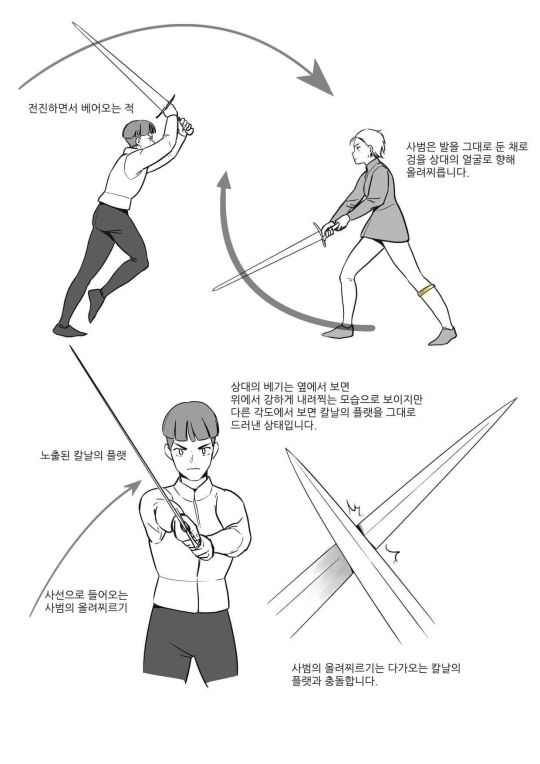
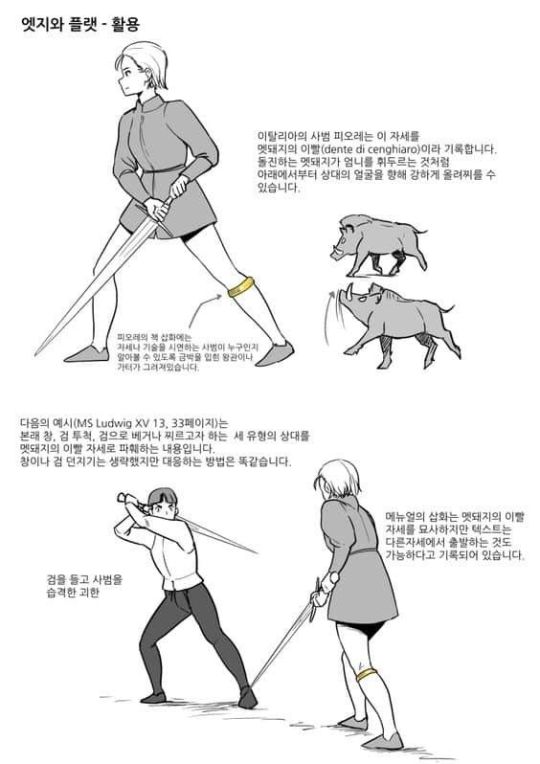
No idea if this Korean manual deals with explanations that pertain uniquely to Fior di Battaglia (They'e using Posta Dente di Cenghiaro and the golden garter symbology) but making an modernly illustrated translation + guide to Fiore's Armizare sounds like a great retirement project...
27 notes
·
View notes
Text
Greetings and Salutations! Commissions Open!!
Commission me on artistree! They use your money to plant trees!
Read my horror comic Dreams for Sale on Webtoon and Tapas!!!!!
Buy a print!
I'm Brian (he/him) and I make art. This blog is mostly for my illustrations, but I also do comics, short and weird writing, and vocal synth music. I have a sideblog for reblogs, doodles, and photographs. You can find me on Instagram with art and music, and YouTube with music.
I have a short comic on Webtoon Canvas and Tapas, and I have a longer one currently in the works!
Here is a guide to what I post on this blog:
Star Trek: This is what I'm doing right now. Lots of Data. I swear I'm a comic artist, I swear I'm working on my original projects, but. . . Data. . .
Dreams for Sale: A horror anthology about the colliding paths of a journalist and a shopkeeper.
Status: Monthly updates starting THIS HALLOWEEN!
Forget Me Not: A drama about mental illness, loss, talent, and rock music.
Status: scripting in progress
Cicada Season: A short story about the unsettling events that occur before an aspiring writer goes off to college.
Status: scripting in progress
1920s story, currently untitled: A supernatural horror story involving a private detective and the. . . person. . . he finds by the side of the road.
Status: saved for later
Beautiful Machine: A sci-fi story about a guy with an android repair shop, his assistant, and an android who refuses to be turned off.
Status: saved for later
Circuit: A far-future sci-fi mystery about the power source of a country that exists entirely in an underground silo.
Status: saved for later
Mari: A surreal story about the way one artist sees the world.
Status: saved for later
Death of the Author: A dark comedy about a struggling author, a spirit, and a medium running a Korean exorcism business out of a New Jersey apartment.
Status: saved for later
Today's reminder: Short and usually surreal posts that I write just for fun!
20 notes
·
View notes
Text
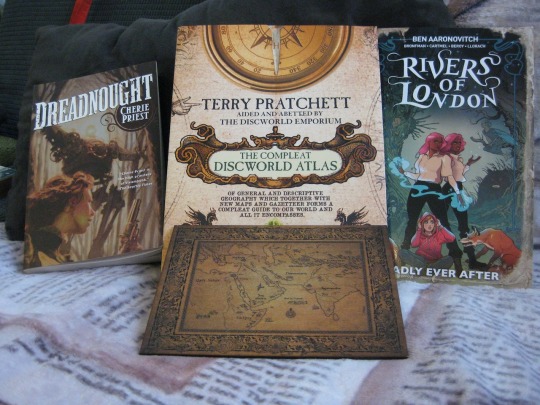
January took forever and February took days. February also saw robins and single-jacket weather and geese migrations, and now it is also seeing December-grade snowfall? The 21st century is weird.
Anyway, I feel like this was another good reading month, even though I had some decidedly all right books in my list and a few moments of "I have hundreds of unread books, why is there nothing to read?!" I managed to offload five (5!) reading copies and only take two in, though I already know I've got two more coming towards me soon because I just can't say no, apparently.
As for book hauls and the TBR shelf situation: I only bought one book, the latest installment of the Rivers of London comics, which I hadn't realized was out so obviously I had to get it. And then read it a couple days later. Also read off my shelves were Dreadnought by Cherie Priest (which had only been on my shelf for 13 years), The Compleat Discworld Atlas, and Jackalope Wives and Other Stories by T. Kingfisher, which isn't pictured because I have the ebook and I couldn't get a good pic of my phone. (People who do this, please send tips!)
And following on from my Digger update from last month: the books are one step closing to shipping internationally! Hooray!
Oh, and a friend with a book box subscription passed a map from the Daevabad Trilogy on to me, so I have yet another decoration for my shelves. Still finding the optimal place for it, and feeling blessed to have such friends.
No idea what March is going to bring, except I feel like there'll be more dithering about reading material.
And now without further ado, in order of enjoyment…
Perilous Times - Thomas D. Lee
Rising sea levels. Mass extinctions. Racists. In-fighting. Dragons. If ever there was a time for the Knights of the Round Table to save the day, this would be it. But can they? Out in May.
8/10
Black main character, 🏳️🌈 main character (gay), British-Indian/Muslim main character; Black, amputee, and 🏳️🌈 secondary characters (trans woman, sapphic, gay)
warning: existential despair, violence
The Compleat Discworld Atlas - Terry Pratchett with the Discworld Emporium
A guide to the Disc, with maps in.
8/10
The 2000s Made Me Gay - Grace Perry
Essays on pop culture and queerness.
7.5/10
🏳️🌈 author
warning: discussions of homophobia
The Porcelain Moon - Janie Chang
Faced with an arranged marriage, Pauline decides to travel to the Western Front to find her cousin. Meanwhile, Camille is caught between an abusive marriage and her secret love for a Chinese translator.
7/10
Chinese main and secondary characters, secondary character with discalculia, Chinese-Canadian author, 🇨🇦
warning: rape, domestic violence, racism, miscarriage
Jackalope Wives and Other Stories - T. Kingfisher
Short stories and other writings.
7.5/10
Dreadnought - Cherie Priest
Mercy travels from Tennessee to Washington Territory to visit her estranged father, two decades into the American Civil War. It won’t be easy.
7/10
Black and Mexican secondary characters
warning: war, gore, occasional racial slurs, including the N-word
The Fairy Tellers - Nicholas Jubber
Explorations into the history of fairy tales and the people who told them.
7/10
contains discussion of and biographies for Syrian and Indian tale tellers
Rivers of London, Vol. 10 - Ben Aaronovitch, Andrew Cartmel, Celeste Bronfman with José María Beroy (illustrator)
Chelsea and Olympia Thames accidentally free an angry artist from a tree near their campsite—but don’t worry, they’ve got a plan.
6.5/10
Black-British main and secondary characters, Korean and Indian secondary characters
Happy Place - Emily Henry
Harriet and Wyn are back in Vermont for their annual friend reunion. This could be the last time, so it’s got to count. Which means nobody can know they broke up months ago. Out in May.
6.5/10
protagonist with depression, Black, Indo-American, and 🏳️🌈 (sapphic) secondary characters
This Winter - Alice Oseman
The Spring siblings would really like a normal Christmas. Shame about this one.
6/10
🏳️🌈 characters (gay, bisexual), 🏳️🌈 author
warning: discussion of eating disorders and mental illness, some of which is distinctly negative
Nocturne - Alyssa Wees
A ballerina in 1930s Chicago acquires a mysterious patron and finds herself in a fairy tale. One of the dark ones.
7/10
warning: abuse, grief, coercion
Full of Briars - Seanan McGuire
Quentin’s parents want to take him away from his found family.
6/10
🏳️🌈 protagonist (bisexual), 🏳️🌈 author
Under Lock & Skeleton Key - Gigi Pandian
Tempest is home after her magic show ended in disaster. Then her former assistant is found dead inside an old wall, and it might have something to do with the family curse.
4.5/10
Indo-American protagonist, Black and Indo-American secondary characters, 🏳️🌈 side characters, Indo-American author
Currently reading:
The Magician’s Daughter - H.G. Parry
Biddy’s magical guardian is under attack and she must leave her island home to protect him.
Stats
Monthly total: 13 Yearly total: 25/140 Queer books: 4 Authors of colour: 2 Books by women: 9 Authors outside the binary: 0 Canadian authors: 1 Off the TBR shelves: 4 Books hauled: 1 ARCs acquired: 2 ARCs unhauled: 5 DNFs: 0
January
#books#booklr#bookblr#adult booklr#book covers#book photography#my photos#reading wrap-ups#read in 2023
19 notes
·
View notes
Text
The most vivid and detailed dream yet, from a morning nap
2d drawing monsters at the back alley walls of "my" neighborhood, walked towards there which was 3 houses away from mine, saw even more of these 2d animated monsters and theyre some chill guys just walkin and hanging out but i got called to go back home and continue dressing us
saw my classmates and the rest of the neighborhood walking down this hallway and told these adorable 2d guys to shoo away and hide but it seems they disappeared as the crowd of people walk in, i think im the only guy that can see these 2d creatures
continued dressing myself up as some my classmates are inside of this house and the others at the one window shit talking to each other
our house is modernist though in some broke ass concrete hollow blocks area and/or roughly painted walls
Went okada via dad's tricycle,mom and our grandparents in the side car, me and my sister at the back of dad, we're zooming down the highway like we're in some extreme sports game and now we're flying and glinding n shit.
tricycle transformed into a lot of these 4 wheeler car forms that are waaaaaay larger than normal as we're running inside of a mall destroying things. im insulting my mother as this was happening
left the tricycle all by myself and biked away from them into a highway while they're still driving indoors of a large mall. my fanny pack has my water bottle stickign out of it from the left.
3rd person POV, bike broke down went to an abandoned hinge shop but its locked and closed so i went on my own.
back to regular ol' first person POV, inside the okada, all lone by myself
Left alone to the hallway urinal/hand wash combo thing, these are so high tech, the mode is determined on what you pressed and it moves the nozzle downwards to show what formula and/or adjective combo its doing and using
most of what i remembered of what the urinal cleaning nozzle on the outside hallway looks like. it can wash the urinal itself, wash your hands and whatnot

saw a woman and her two kids, the 2 children want to use them but failed a bit as they get little soap, the mother walked away after she did her's, so i teach these two children on how to use these funky things and after a long lesson i guide push them back to their mother.
Checked my app that's connected to all of these hotel urinals, illustrations implying sexual tension, the app thinks im gay and i have a boyfriend with me, i tricked the app into thinking my sibling or my "bf" is using it by moving my phone a bit away from the urinal/handsoap thingy.
Walked back to Play around with the ice cream machine and it's Zenless Zone Zero Collab stuffs after i saw a guy setting up their pink strawberry ice cream with a zhu yuan cup, so i explored the fuck out of this machine, saw more large tub of ice cream art options (i was searching for grace howard) and moved the lever for more options, saw an option or archive of all of these waiting for ice cream animations which is the characters beating up an etheral or for some reason a bangboo.
why is corin, von lycaon, and billy beating up a bangboo at an orange mostly circular arena in the waiting screen?
this is most of what i remembered about the ice cream machine, selection of the ice cream itself on the middle? zzz promotion on the upper right side??? i forgot what it looks like

Washed my legs with the ice cream machine bottomless, no pants, no underwear, wanting to shit so I went to sit on the urinal, two school girls seeing this bullshit of me (fucking disgusting of me tf this was a tiny awkward moment), then go in the unlabeled bathroom, which was those two girls were going in for before they saw what i was doing, which was for women (this has a whole gigantic pile of those grey plastic arm chairs) all the women inside looked at me and this other big korean dude like we're some creeps (which is justified considering the situation),so I went to the other one that's unlabled on the outside, and labels unisex ON THE INSIDE, I'm one of two dudes waiting in the large bathroom full of school armchairs arranged for us to sit, line up, and wait. the women here in the unisex side of the bathroom told us that yes this is connected to that women's only bathroom.

Woke up 11:30 AM where mom is showing the new nikes i own
that ending was fucking weird.
0 notes
Text
Book Review: Great to Good

Does God want us to be great or good? In Great to Good, Jae Hoon Lee compellingly shows how following Jesus reshapes our ambitions.
Reset and Recalibrate
Lee helps us understand that Christians should not strive for greatness in the eyes of the world, but rather focus on being good in terms of our faith, which is to be lived out through our actions. As followers of Christ, we are called to be the light of the world and the salt of the earth, to do good deeds, and to embody Christ's love in tangible ways.
The book is divided into 50 short chapters, each one powerful, thought-provoking, and encouraging. I can easily imagine this book being used as a daily devotional to reset and recalibrate the heart, guiding readers toward humility and a deeper alignment with Christ.
Tearing and Mending
One of Lee’s greatest strengths is his ability to paint vivid word pictures. He illustrates complex spiritual truths with remarkable clarity. The idea that God transforms us through a process of "tearing and mending" particularly struck me. Lee explains how the cross of Christ tears away the evil within us, and then, through God's grace, sews us back together, restoring our relationship with Him. This "spiritual surgery" is a compelling way to understand how God works in our lives, and Lee does an excellent job helping readers grasp this profound spiritual reality.
What I found especially refreshing is how Lee unapologetically draws from his own experience and cultural background as a Korean. As the senior pastor of Onnuri Church, chair of The Gospel Coalition Korea, and co-chair of the host committee for the 2024 Lausanne Congress on World Evangelism in Seoul, Lee’s insights are shaped by his self-reflection on the Korean church. While the book is written for a global audience, Lee does not shy away from his identity or heritage, making his message all the more authentic and personal.
Good and Faithful
Though the truths Lee presents are timeless, he also writes prophetically about our current cultural moment. In Chapter 28, Lives Are More Important than Rights, Lee addresses the legal vacuum surrounding abortion in South Korea following a Constitutional Court ruling that declared the country's restrictions on abortion unconstitutional. He challenges church leaders in South Korea, the United States, and around the world to lead their communities toward a culture that upholds the sanctity of life.
After reading this book, I am left with renewed courage and a clearer sense of calling. To live the Christian life is to forsake worldly pursuits and follow Christ wholeheartedly. My prayer is that I may one day hear the Savior say, "Well done, good and faithful servant."
I received a media copy of Great to Good and this is my honest review. Find more of my book reviews and follow Dive In, Dig Deep on Instagram - my account dedicated to Bibles and books to see the beauty of the Bible and the role of reading in the Christian life. To read all of my book reviews and to receive all of the free eBooks I find on the web, subscribe to my free newsletter.
0 notes
Text
Hangul and Vocabulary in Korean Language: An Illustrated Guide
The Korean language is a fascinating and complex system, with a unique writing system and vocabulary that reflects the country's rich cultural heritage. In this article, we'll take a closer look at Hangul, the Korean alphabet, and explore some essential vocabulary words and phrases to get you started on your Korean language journey.
Hangul: The Korean Alphabet
Hangul is a unique and scientifically designed alphabet that consists of 14 consonants and 10 vowels. It's considered one of the most logical and easiest to learn alphabets in the world.
Consonants:
(g/k) - sounds like "g" or "k"
(n) - sounds like "n"
(m) - sounds like "m"
(s) - sounds like "s"
(ng) - sounds like "ng"
(j) - sounds like "j"
(ch) - sounds like "ch"
(k) - sounds like "k"
(t) - sounds like "t"
(p) - sounds like "p"
(h) - sounds like "h"
Vowels:
(a) - sounds like "ah"
(ya) - sounds like "yah"
(eo) - sounds like "uh"
(yeo) - sounds like "yuh"
(yo) - sounds like "yo"
(yu) - sounds like "yu"
(u) - sounds like "oo"
(e) - sounds like "eh"
(ye) - sounds like "yeh"
(i) - sounds like "ee"
Vocabulary: Essential Words and Phrases
Here are some essential vocabulary words and phrases to get you started:
(annyeonghaseyo) - Hello
(gamsahamnida) - Thank you
(joheunhamnida) - Excuse me/Sorry
(ye) - Yes
(aniyo) - No
(joh-ah-ha-mnida) - I like it
(joh-eun nalssi-eoyo) - The weather is nice
(eodie issna-yo?) - Where are you from?
Illustrated Guide
Here's an illustrated guide to help you remember some of the essential vocabulary words and phrases:
[Image of a person saying "" (annyeonghaseyo) - Hello]
[Image of a person saying "" (gamsahamnida) - Thank you]
[Image of a person saying "" (joheunhamnida) - Excuse me/Sorry]
Conclusion
Hangul and vocabulary are the building blocks of the Korean language. By mastering the Hangul alphabet and learning essential vocabulary words and phrases, you'll be well on your way to becoming proficient in Korean. Remember to practice regularly and use visual aids like illustrations to help you remember new words and phrases.
0 notes
Text
What's the vibe? #63

Cannes wrapped up > next interesting festivals in August are Locarno and Venice (where I think we're getting a new Luca Guadanino film).
The Euros start next week. First England game is on the 17th June and they're up against Serbia.

French Open still going strong til the 9th - a women quarter final to check out is Coco Gauff v Ons Jabeur today, right now.
Isamaya x FaceGym collab and cosmetic surgery tourism:

Isamaya Ffrench has releases a gua shua metal accessory in collaboration with FaceGym. This non invasive cosmetic "procedure" if you can call it that, is an example of 1, the rise in this traditional, culture based way of approaching health and 2, related to the want for non invasive techniques.
The former - relating to maybe "decolonial" ways of living - "how did my grandma do this and is it related to today? does it work first of all?" You could also see this strand of thought going into storytelling, unfamiliar territory for some but I think that if Hollywood is obsessed with IP that already exists, that newness is risky for them. Independent wise, the base is built, the curiosity set up in adventurous watchers who love Letterboxd, so could work in that context. (Maybe this is West specific, the rest of the world is obviously going to delve into national myths.)
One of the biggest reasons in the big Korean soft power exploding alongside the fact that the music, food and general culture is big is beauty tourism. Korean skincare exploding has people looking at their "cutting edge" treatments to improve themselves on holiday. A little botox at 1, colour matching at 2.30, great dinner at 5.
Curating and individualism:
This is a funny read - as with many things about culture I never find people go deep enough about anything. I find that when people discuss trend cycles or something they've been in it for a while but now it's just...culture. It's the pouring of 300 bottles of liquor to create the glorious cocktail. They lack - I find it uninteresting
"are we killing culture?" isn't even a real idea or question. Culture will shift, mutate, regroup. I even think because of almost a year of activism, some tactics will be borrowed - it might be of the same speed/faster/underground or aggressively IRL because that's where you find
At the end of the piece, there's this link which was attached to the phrase "find our way back to reality".
IDK - even this doesn't move me - it's very stiff in terms of what to do. Like what do you enjoy? What's your perspective on things? There's consumption but people like enjoyment....which is why they consume? The most interesting writings or stuff is like maybe visiting Cafe Oto. You can observe from outside, hear the muffled sounds, enjoy a chat with a friend, go inside, experience something weird, different, go back out, write down observations, go back in and maybe read a little on stage to the audience and see how they feel about it.
I think now we've gotten near to peak curation, a lot of hidden gems are found and easily accessed - which is great for people, sometimes not great for creators, or businesses that are suddenly overwhelmed unnecessarily.
from above: "Structurally, the Internet is not getting better anytime soon; I have not hidden my pessimism about its future. But human creativity persists, even in hostile conditions. Figures like Gee, Reilly, and Shuherk make me hopeful that fun, interesting niches of activity can still survive online. There’s another word that we might apply to such people: “connoisseurs,” in the art-historical sense of passionate observers who shape a discipline through their judgments. We’ve always had connoisseurs, from the radio d.j. to the bookstore clerk, subtly but vitally informing the culture that the rest of us choose to consume. As Shuherk put it, “The person in the nineties working at Blockbuster—we’re the same person.”
I do think that the backlash to a lot of this in the next few years (or months) is just extreme gatekeeping especially for spaces for more marginalised people. Everyone wants to go to the cool thing but tourism decreases the legitimacy.
We're also in extreme tough economic times - see Black Keys, J-Lo cancelling US tour dates, Melt Festival in Germany stopping after 27 years due to changing festival landscape, (Maybe even Jamie XX doing a 10 night residency at Venue MOT). These examples to say anything smaller than the super established runs at a risk. It's hard to create culture when you can't pay rent but also hard to keep going if your audience extract the uniqueness from your creation.
from above: "An exasperated Dominic Cook, a former director at the Royal Court theatre, last month went so far as to call for renationalising the arts. His point, provocatively framed, was that the current system is broken. The model that worked when he started out in the late 1980s — when generous state funding and box office receipts combined to more or less cover costs ��� now requires hefty supplemental doses of private funding. "
We deeply need funding bodies to keep culture flowing - whether some new Medicis want to step in or "ethical" funding bodies or the government, we'll be happy nonetheless.
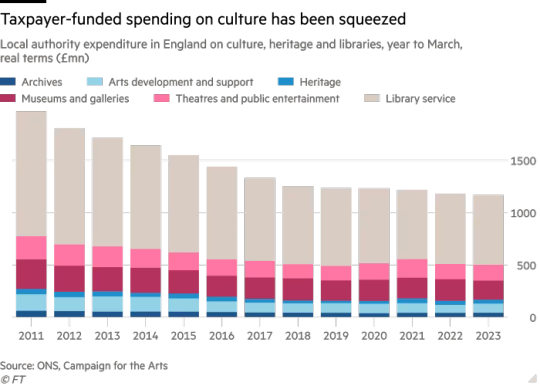

I mean this also doesn't mean that cool things aren't happening in industries such as film. For example something like not/nowhere or other cinemas are giving people the chance to learn new skills and showcase work.
4 the dating data heads:
androgyny dressing:
0 notes
Text
Nailing Your English Job Interview: A Vital Preparation Guide
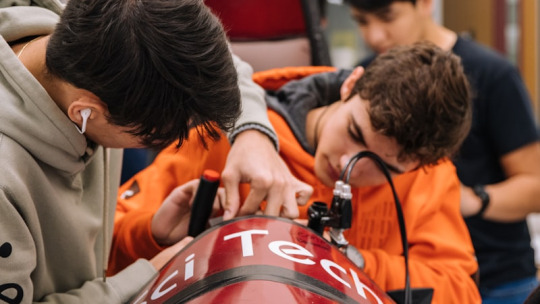
Preparing for an English job interview is like studying a new language. It demands practice, preparation, and a lot of fortitude. Just like the Austin Korean classes near me or the Austin German classes near me, you need to put in the time and effort to be proficient. From learning how to answer standard questions fluently to practicing good non-verbal communication, diligence is necessary. Heck, even the Austin Arabic classes near me and Austin Hindi classes near me need a certain level of dedication! Just as studying foreign languages requires focus on syntax, pronunciation, and grammar, so does preparing for an English job interview. Just like the Austin English courses near me, you need to focus on speaking clearly, structuring your responses, and using appropriate professional vocabulary. So, put your best foot forward and make a solid first impression by prepping correctly!
Mastering the Art of Interview Preparation and Presentation
When embarking on the journey of landing your ideal role, being well-prepared for the interview process is crucial. This involves researching the company and planning your responses ahead of time. Here are a few tips on how you can articulate your qualifications and work experience more effectively.
Do your homework: Research the Company
Understanding the company's mission, culture, products, and overall brand identity can set you apart from other candidates. Take your time to:
Explore the company's website, social media, and recent news.
Familiarize yourself with the company’s values and interests.
Understand the company's products, services, and target customer.
This will help you tailor your answers and show the interviewer that you're serious about the opportunity.
Plan Your Responses: Show Off Your Skills
Well-prepared responses can demonstrate your skills, experience, and overall suitability for the position. Here's how:
Anticipate likely interview questions and prepare concise, focused responses.
Use real-world examples to illustrate your skills and experience.
Practice your responses to ensure you present them naturally.
Remember, your goal is to convince the interviewer that you have the skills, knowledge, and experience to effectively perform the role.
Articulate Your Qualifications: Be Specific
When talking about your qualifications:
Mention the specific qualifications you hold and how they're relevant to the job.
Describe how you have utilised these qualifications in your past roles.
Offer examples of projects you've worked on or successes you've had because of these qualifications.
Discuss your Working Experience: Tell a Story
Your work experience is more than just jobs and dates. Use it to tell a compelling story:
Highlight key roles and responsibilities you've held.
Discuss the skills and knowledge you've gained.
Show how your past experience will help you succeed in this new role.
Remember, it's not just about what you did—it's about how you did it and the impact you made.
By doing diligent research, preparing your responses, and articulating your qualifications and work experience effectively, you stand a better chance of making a positive impression and securing the job you desire. Happy interviewing!
Navigating English Interview Questions With Confidence
Are you gearing up for an English-language job interview? While it's perfectly normal to feel nervous, a bit of preparation can go a long way in boosting your confidence. Here, we'll guide you through common interview questions in English and help you plan your responses. Remember, an accurate and appropriate use of English is key to acing your interview.
Common English Interview Questions
Check out the following common English interview questions:
Tell me about yourself.
Why should we hire you?
What are your strengths and weaknesses?
Where do you see yourself in five years?
Why do you want to work here?
How do you handle stress and pressure?
Describe a difficult work situation and how you overcame it.
What are your goals for the future?
Why are you leaving or have left your job?
How do you evaluate success?
Planning Your Responses
Now let's break down how to effectively plan your responses:
Be specific: Avoid generic answers. Instead, share specific experiences or accomplishments that demonstrate your skills relevant to the position.
Use the STAR method: Situation, Task, Action, Result. This technique is particularly useful for behavioral interview questions.
Tailor your answers: Shape your answers to align with the job requirements and company culture.
Practice: Record your answers and listen to them. This helps to verify your language proficiency and the quality of the content.
The necessity of accurate and appropriate English use in an interview setting cannot be overstressed. It's not just the content of your responses that matter, but also how you communicate them. Fine-tune your English proficiency and increase your chances of acing your interview by investing in one-on-one tutoring sessions with qualified teachers on AmazingTalker. No contracts, transparent pricing, and flexible lesson options are guaranteed. Plus, you can have a discussion about the course content with the teacher before classes. Don't leave your interview success to chance. Prepare today with AmazingTalker.
Seizing Success: The Value of English Test Preparation and the Role of AmazingTalker
Whether you're interviewing for a job, applying for a scholarship, or seeking top-tier university acceptance, your ability to communicate effectively in English is crucial. Hence, preparing for English tests not only sharpens your language proficiency but also provides the competitive edge that sets you apart.
Confidence Boosting Benefits
Imagine walking into an interview and impressing the panel with your fluent English. Test preparation:
Helps you demonstrate your language capability convincingly,
Increases your self-confidence,
Enhances your comprehension skills, and
Showcases your dedication and discipline.
Introducing AmazingTalker: Your Personalized Learning Partner
While an EF SET Certificate might help, there's a platform that offers an approach tailored to your specific needs: AmazingTalker. As an innovative language learning platform, AmazingTalker provides:
Personalized one-on-one teaching with customized materials,
Transparent qualifications and experience of tutors,
No requirement of contracts along with transparent pricing, and
Flexible lesson options to accommodate your schedule.
You can select a teacher based on your budget, requirements, and available slots. The platform also facilitates discussion on course content with teachers before classes. To ensure that you're making an educated choice, it even offers a 25-minute trial lesson.
AmazingTalker is not just confined to English—it proudly offers online courses in 48 different languages, including Japanese, Korean, Spanish, French, and German. So whether your ambition drives you towards becoming a polyglot, or you're focused on mastering English, AmazingTalker is the answer to your language learning needs.
Refining English Speaking Skills Through Practice
When learning a new language, the importance of practice cannot be overstated. It's not just about memorizing words and phrases but also getting the chance to use them in a real conversation. This can help boost your confidence and refine your speaking skills. One effective method to practice your English is by speaking aloud or recording yourself.
Speaking aloud allows you to hear how you sound, giving you the chance to correct any pronunciation mistakes you may make. As the saying goes, practice makes perfect. The more you practice, the easier it becomes to form sentences and express your thoughts in English.
The same goes for recording yourself. By listening to these recordings, you can identify your strengths and areas that need improvement. You can also see your progress over time, which can be a great confidence booster. This will also help you to become more fluent and natural in your speech.
Here are some tips when practicing speaking aloud or recording yourself:
Make it a routine. Set aside time each day for practice.
Start with easy words and phrases, then gradually move on to more complex sentences.
Listen to English speakers and try to mimic their pronunciation.
Don't be too hard on yourself. Making mistakes is part of the learning process.
Keep a positive mindset. Believe in your ability to improve.
Remember, practice is key in mastering any language. With consistent effort and the right strategies, you'll be speaking English confidently and fluently in no time.
How AmazingTalker Assists with Interview Preparations
AmazingTalker, a pioneering online English tutoring platform, provides an array of services to help you prepare for interviews. This platform offers personalized one-on-one teaching, allowing learners to focus on specific areas they wish to improve. Whether it's honing your English communication skills or understanding the nitty-gritties of cracking an interview, AmazingTalker has got you covered.
Personalized Learning Experience
One-on-one teaching: Tutors provide individualized attention, helping you to focus on your areas of improvement.
Customized materials: Tutors prepare personalized resources tailored to your specific needs and goals.
Transparent and Experienced Tutors
Transparent qualifications: AmazingTalker provides complete clarity on the experiences and qualifications of its tutors. This transparency allows you to choose a tutor who meets your requirements best.
Experienced tutors: AmazingTalker houses a pool of experienced tutors trained in various fields, including interview preparation.
Flexible and Transparent Pricing
No contracts: AmazingTalker does not bind you in contracts. Enjoy the flexibility of learning at your own pace.
Transparent pricing: All prices are clearly stated, with no hidden charges.
Flexible lesson options: Choose a lesson package according to your needs and schedule.
Choose Your Own Teacher
Selecting teachers: AmazingTalker enables you to select a teacher based on your budget, requirements, and schedule.
Discuss course content: You can discuss the course content with the teacher before starting the classes.
Trial lesson: For your comfort, AmazingTalker offers a 25-minute trial lesson. This helps you to understand the teaching style of the tutor and align your expectations.
Despite its focus on English teaching, AmazingTalker also offers online courses in 48 other languages including Japanese, Korean, Spanish, French, and German.
In a nutshell, AmazingTalker opens a world of opportunities to boost your interview preparation journey. With personalized teaching, experienced and qualified tutors, transparent pricing, and the flexibility to choose your teacher, AmazingTalker empowers you to approach your interviews with confidence.
Harness the Power of English Mastery with AmazingTalker
In conclusion, preparing adequately for an English job interview is paramount. A lack of preparation can be detrimental, hindering your chances of landing the job. From communicating eloquently to understanding the nuances of the English language, every aspect counts. It's not just about knowing the language, it's about showcasing your skills and presenting your best self on the big day. So, why limit your potential due to a language barrier? With AmazingTalker, you can expertly boost your English proficiency. The platform offers personalized learning experiences that align with your individual needs, ensuring you become confident in your English speaking ability. So, take the plunge today. Be daring, be persistent, seize your opportunity with AmazingTalker. With the right resources and guidance, you can bring your A-game to any English job interview and secure that dream job. AmazingTalker is here to help you turn your goals into achievements. After all, your success is a reflection of your preparation. Let's make it count!
0 notes
Text
Personal Statement
Hello, I am Mariia Buhaievska and I am from Ukraine. I was born and lived my entire life there, until I came to Korea for my undergraduate studies. At this moment in life, I am a learner, still discovering who I am and who I want to become. My deep interest in various forms of design has brought me to Yonsei UIC, where I am majoring in CDM (Culture and Design Management) and IID (Information Interaction Design).In the realm of art and design, I have experienced variety of different aspects. Starting with an official Art school, I learned traditional art, sculpture, and art history. I have also explored art and design on my own, creating graphic illustrations and animations through Procreate. At Yonsei, I have enhanced my skills in Blender, Unity, Adobe Photoshop, Adobe Illustrator, Adobe XD, Adobe Premiere, and MetaSpark Studio. I still must admit I am not as good with Touch Designer.
As a junior, I am seeking work experience in the design field. Currently, I have a part-time job as a graphic designer and product manager with the Ukrainian brand SweetStone. There I design packaging for their products and work on prototyping and production. Additionally, I am working as an RA (Residential Assistant) in the Appenzeller House for the third semester in a row. There, I guide freshman students, design programs, and collaborate with an RA team to organize large-scale events (approximately 150-200 people). I was a member of the DFK (Design Factory Korea) club and have also organized a Mockup Session event in collaboration with them.Beyond the design sphere, I am an introverted person who enjoys meaningful conversations with others yet cherishes time alone to find balance. Having recently adopted a cat, I now have much more home time than before :)
As mentioned, I appreciate the company of others and value understanding their perspectives. My favourite places are the high mountains and grassy fields; I am a true nature person who would prefer collecting mushrooms in the forest over a night out at a party. I enjoy drawing with gouache paints, creating 3D models in Blender, and surfing (even though I am not that good at the last one). Through the analysis of my favourite things, I have found my own style in art and life. Specifically, I've discovered that I enjoy depicting issues through nature by incorporating hard meanings into aesthetically pleasing elements, such as flowers (examples of which are available in my portfolio). I enjoy uncovering new design features and learning more about myself throughout the course. It was a really pleasant moment when I was able to create 3D models and environments on my own during my previous semester; it felt like unlocking a new level in a game, revealing fresh opportunities in design.
During this course, I am eager to learn more about gamification, which I believe is deeply connected with human psychology and thought processes—an area that fascinates me. I aim to understand why people prefer certain content or applications over others.
My current dream is quite straightforward: to financially support myself and my parents while living peacefully in a nature-centric area. I want to live near mountains or the sea, perhaps in a place similar to Jeju Island, where I can surf and work remotely. My plan to realize this dream involves working as a designer in a Korean or US company to build my reputation among fellow designers and 3D modellers. Eventually, I intend to transition to freelancing and online work.
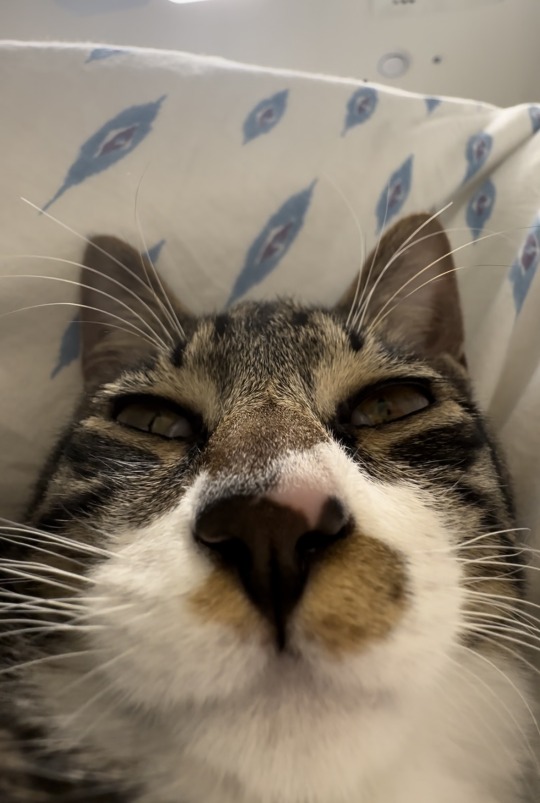
thank you
0 notes
Text
Adobe InDesign Induction

Unlike the Photoshop and the Illustrator session, the InDesign induction has 3 sessions in total. To be honest, I have a lot of difficulty during each session because this app is more complicated than the other apps I’ve already learned. But I think this InDesign Induction is really important and have a lot of benefit with someone that have an interest in zine and newsletter making. Here’s my InDesign Induction results and my learning process.
Adobe InDesign First Session
In this session, we learn a few tool/feature such as columns and gutter, margins, bleed, workspaces, parent pages overriding parent pages, setting up grids and guides, baseline grid, setting up a spread, linking items, frames and placing images, fitting, shape tools, etc. And after that we’re going to make a design of a newspaper or a zine. And this picture below is my design. I made a zine design of my favourite Korean idol, Lee Haechan😍🐻



Adobe InDesign Second Session
The next session, we learn to make a brochure design. And this time, I made another NCT inspired design again! I’m pretty satisfied with the result. At first we’re taught about the page layouting for a brochure. Where we should put the front side, the back side, and etc. Then we’re doing the design layout as we’ve already learned on the first session.




Adobe InDesign Third Session
For the last session we’re doing a really quick practice. We’re asked to edit a messy zine design into a neat design. It’s quite hard because the time is limited and I forget a few of the tools tutorial I’ve already learned. It’s not look the best, but here’s my result.


1 note
·
View note